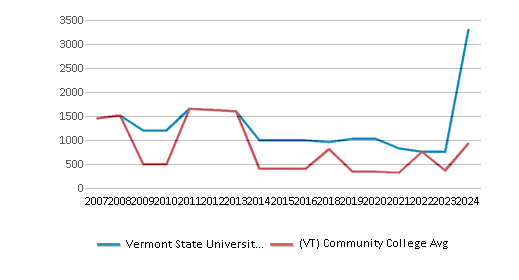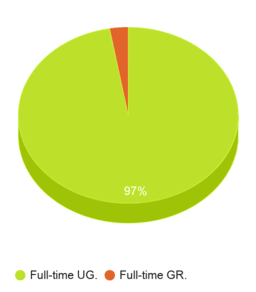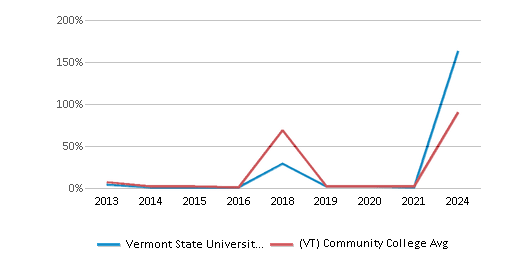School Highlights
Vermont State University serves 7,540 students (45% of students are full-time).
The college's student:teacher ratio of 28:1 is higher than the state community college average of 16:1.
Minority enrollment is 19% of the student body (majority Hispanic and Black), which is less than the state average of 22%.
Quick Stats (2025)
- Enrollment: 7,540 students
- In-state tuition: $12,860
- Out-state tuition: $23,708
- Acceptance Rate: 56%
- Student:teacher ratio: 28:1
- Minority enrollment: 19%
- Source: Verified school update
School Overview
The teacher population of 270 teachers has stayed relatively flat over five years.
Vermont State University
(VT) Community College Avg.
Carnegie Classification
Baccalaureate/Associate's Colleges: Mixed Baccalaureate/Associate's
Baccalaureate/Associate's Colleges: Mixed Baccalaureate/Associate's
Institution Level
Less than 2 yrs
Four or more years
Institution Control
Public
Private not-for-profit
Total Faculty
270 staff
204 staff

Student Body
The student population of Vermont State University has grown by 342% over five years.
The student:teacher ratio of 28:1 has increased from 6:1 over five years.
The Vermont State University diversity score of 0.34 is less than the state average of 0.38. The school's diversity has grown by 32% over five years.
Total Enrollment
7,540 students
1,071 students

Student : Teacher Ratio
28:1
16:1

# Full-Time Students
3,405 students
430 students

# Part-Time Students
4,135 students
641 students



# Enrollment Undergraduate
552 students
393 students
# Full-Time Undergraduate Students
3,312 students
430 students

# Full-Time Graduate Students
93 students
33 students



# Part-Time Undergraduate Students
n/a
512 students
# Part-Time Graduate Students
n/a
810 students
Total Dormitory Capacity
n/a
118 students

% American Indian/Alaskan
n/a
n/a

% Asian
1%
2%

% Hispanic
4%
5%

% Black
3%
4%

% White
81%
78%

% Hawaiian
n/a
n/a

% Two or more races
3%
4%

% Non Resident races
2%
1%

% Unknown races
5%
6%


Diversity Score
0.34
0.38

College Completion Rate (Students who graduate in less than 4 years)
n/a
24%
College Completion Rate (Students who graduate in 4 years or more than 4 years)
0.5442%
0.3404%
Average Graduate Earnings (10 Years)
$45,300
$30,700

Tuition and Acceptance Rate
The public in-state tuition of $12,860 is more than the state average of $6,570. The in-state tuition has declined by 19% over four years.
The public out-state tuition of $23,708 is more than the state average of $12,134. The out-state tuition has declined by 19% over four years.
In-State Tuition Fees
$12,860
$6,570

Out-State Tuition Fees
$23,708
$12,134

% Students Receiving Some Financial Aid
96%
96%

Median Debt for Graduates
$13,000
$19,042

Median Debt for Dropouts
$9,500
$5,500

Acceptance Rate
56%
62%

SAT Total Avg.
1,375
1,375
SAT Reading
455
455

SAT Math
485
485

SAT Writing
435
435

ACT Total Avg.
62
61
ACT Composite
22
21

ACT English
19
19

ACT Math
21
21

Source: 2024 (or latest year available) Integrated Postsecondary Education Data System (IPEDS) , School Administrators
Frequently Asked Questions
How much does Vermont State University cost?
Vermont State University's tuition is approximately $12,860 for In-State students and $23,708 for Out-State students.
What is the acceptance rate of Vermont State University?
The acceptance rate of Vermont State University is 56%, which is lower than the state average of 62%.
In what neighborhood is Vermont State University located?
Vermont State University is located in the Randolph Center neighborhood of Randolph, VT.
Recent Articles

Obtaining Your Bachelor's Degree at a Community College
Explore the evolving landscape of community colleges offering bachelor's degrees, addressing affordability, accessibility, and workforce needs.

A to Z of Community College Certificates and Courses
From business and healthcare to technology and skilled trades, the article showcases the breadth of options available to students seeking to enhance their knowledge, develop new skills, or pursue career advancement.

What is a Community College?
This comprehensive guide explains what a community college is, its history, and its role in higher education. It covers the types of programs offered, differences from four-year colleges, benefits of attending, and important considerations for prospective students, providing valuable insights for those exploring educational options.




![VERMONT TECHNICAL COLLEGE 2021 COMMENCEMENT SATURDAY, MAY 22 | 11 AM [Closed Captioning is available]Countdown to the virtual commencement pages where you will be able to download your special social graphics to share your graduation with all your friends and family: www.vtc.edu/grad2021View the full program here: http://ow.ly/cpk850ESEkoPRESIDENT’S WELCOME: Patricia Moulton
STUDENT SPEAKER: Schylar Corsones-Brown
ALUMNI ASSOCIATION WELCOME: Susan Fredette
CONFERRING OF DEGREES: Patricia Moulton Vermont Technical College's Spring 2021 Virtual Commencement](https://i.ytimg.com/vi/zQV8BibI7bU/0.jpg)





